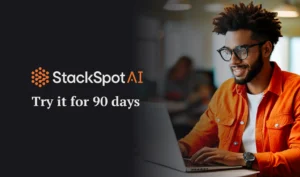For small and mid-size businesses (SMBs), the average cost of IT downtime ranges from $137 to $427 per minute — and for large organizations, the consequences of downtime are even more severe. Given the high downtime costs, creating a robust business continuity plan is essential for businesses of all sizes.
While a lot goes into a business continuity plan, app modernization is one strategy that can help companies become more flexible and resilient. By leveraging an enterprise developer platform (EDP) such as StackSpot EDP to modernize applications and migrate them to the cloud, companies can ensure that their critical applications remain operational even during a disaster.
In short, a developer platform like ours creates, reuses and distributes software standards. By standardizing technical standards, teams can create reliable software, with fast onboarding, promoting compliance and governance, and focusing on business features.
What is a Business Continuity Plan (BCP)?
A business continuity plan (BCP) is a comprehensive strategy to ensure critical business operations can continue during and after a disaster or other unforeseen event.
To help you craft resistant business plans, we’ll cover the role of EDP in business resilience and everything you need to know about enhancing business resilience through modernization. It commonly includes policies, procedures, and technologies to minimize downtime, protect assets, and maintain customer service levels.
Traditionally, business continuity plans have focused on predefined responses to known risks. More modern approaches to business continuity, however, emphasize the importance of adaptability and agility in the face of evolving threats and challenges, and this shift to adaptive strategies is one of the key technology trends to watch in 2024 and beyond.
The Importance of Adaptive Strategies in Business Continuity
Business disruption can stem from various sources, including natural disasters, cyberattacks, and supply chain disruptions, to name a few. Given this wide range of threats and their ever-evolving nature, static contingency plans often need to be revised.
Rather than trying to address every possible threat, modern companies need a continuity plan that focuses on resilience and adaptability. Adaptive strategies empower organizations to adjust rapidly to changing circumstances, enabling them to sustain operations and mitigate the impact of disruptions.
Integrating Adaptive Strategies Into Business Continuity Plans
Integrating adaptive strategies into business continuity plans often requires a shift from rigid, one-size-fits-all approaches to dynamic frameworks that can evolve in real time. This commonly entails adaptive strategies such as:
- Continuous risk assessment: Companies should assess potential threats and vulnerabilities on an ongoing basis. This allows them to identify emerging risks and adjust their strategies accordingly.
- Agile response mechanisms: Agile response mechanisms allow for quick decision-making and resource allocation during a disruption. This can include cross-functional teams, automated response protocols, and clear communication channels.
- Scenario planning: Scenario planning exercises are designed to simulate various crisis scenarios and test the effectiveness of response strategies. By simulating different scenarios, companies can identify gaps, refine their plans, and build confidence in their ability to respond effectively.
Modernization’s Role in Resilience
App modernization is pivotal in a company’s ability to foster resilience and ensure business continuity. For one, modernizing legacy systems and applications improves scalability and flexibility. It allows companies to scale applications dynamically to meet changing demands and unexpected surges in activity, and the flexibility of modernized applications provides for a wide range of other agile adjustments in response to market changes.
Modernized applications offer enhanced cybersecurity thanks to a security-focused design with several built-in security mechanisms. With a record number of data breaches occurring in 2023, cyberattacks are now one of the leading causes of business downtime. App modernization is a primary key to safeguarding applications against these threats.
Along with offering enhanced protection against cyber threats, modernized apps migrated to the cloud are much less vulnerable to natural disasters, power outages, and other events that can disrupt on-premise systems. Modern systems also come equipped with more modern and stable technologies, making them more reliable and less prone to critical failures.
Lastly, modernized applications support seamless remote operations, allowing businesses to continue operations in dispersed or decentralized environments. In cases where the company’s offices are rendered inaccessible, this ability to keep the company operating remotely is key.
Leveraging EDPs for Business Continuity Enhancement
Modernizing legacy applications offers many advantages in bolstering resilience and ensuring business continuity. But it’s also a complicated process that requires the right strategy and tools.
One powerful way to make the process of app modernization much more streamlined and effective is to leverage an EDP. Platforms like StackSpot EDP provide a comprehensive ecosystem of tools, frameworks, integrations, and services perfectly aligned with app modernization initiatives. With these platforms, developers can accelerate the process of app modernization and improve code confidence.
EDPs also allow you to build resilience features into your applications, including automated failover, disaster recovery, and data replication. This further bolsters a company’s ability to withstand disruptions and helps prevent them from causing extended downtime.
Learn more about StackSpot EDP in the video below.
StackSpot Solutions: Strengthening Modernization Outcomes
At StackSpot, we offer numerous solutions designed to support app modernization and improve its outcomes.
StackSpot EDP
This includes an advanced Developer Platform equipped with all the tools, frameworks, and features developers need to streamline the app modernization process. With StackSpot EDP, developers can centralize technology patterns, leverage reusable components for standardization and efficiency, and lean on the context between projects for an app modernization process that offers greater standardization and efficiency.
StackSpot AI
StackSpot also offers a context-aware AI coding assistant that further accelerates application development. This powerful AI coding assistant can support many app modernization projects, including automatically converting old programming languages to more modern ones.
Conclusion
If you want to improve your company’s resilience and create an agile and adaptive business continuity plan, app modernization is a great place to start. To learn more about how using StackSpot to modernize legacy applications empowers adaptive strategies for business continuity, book a demo today!






